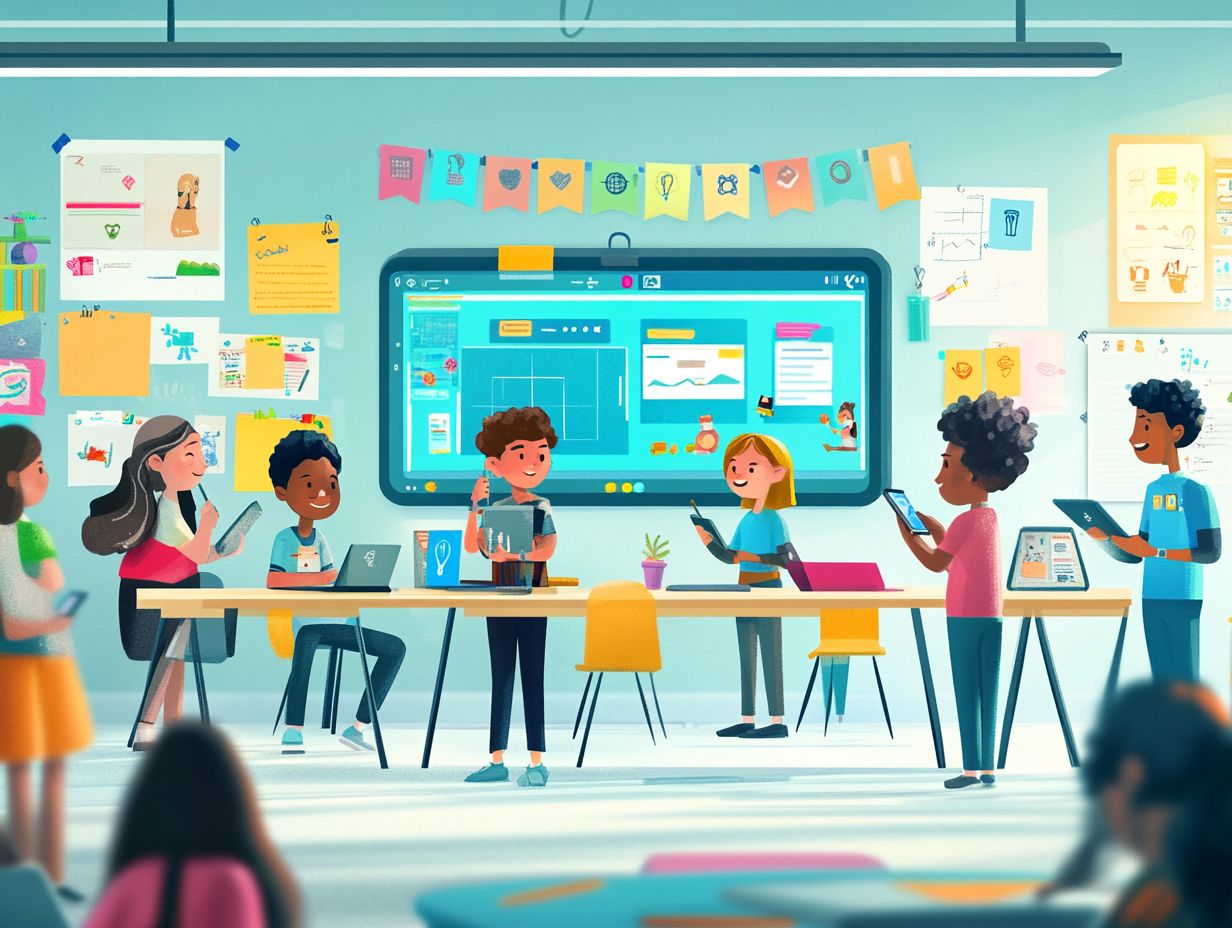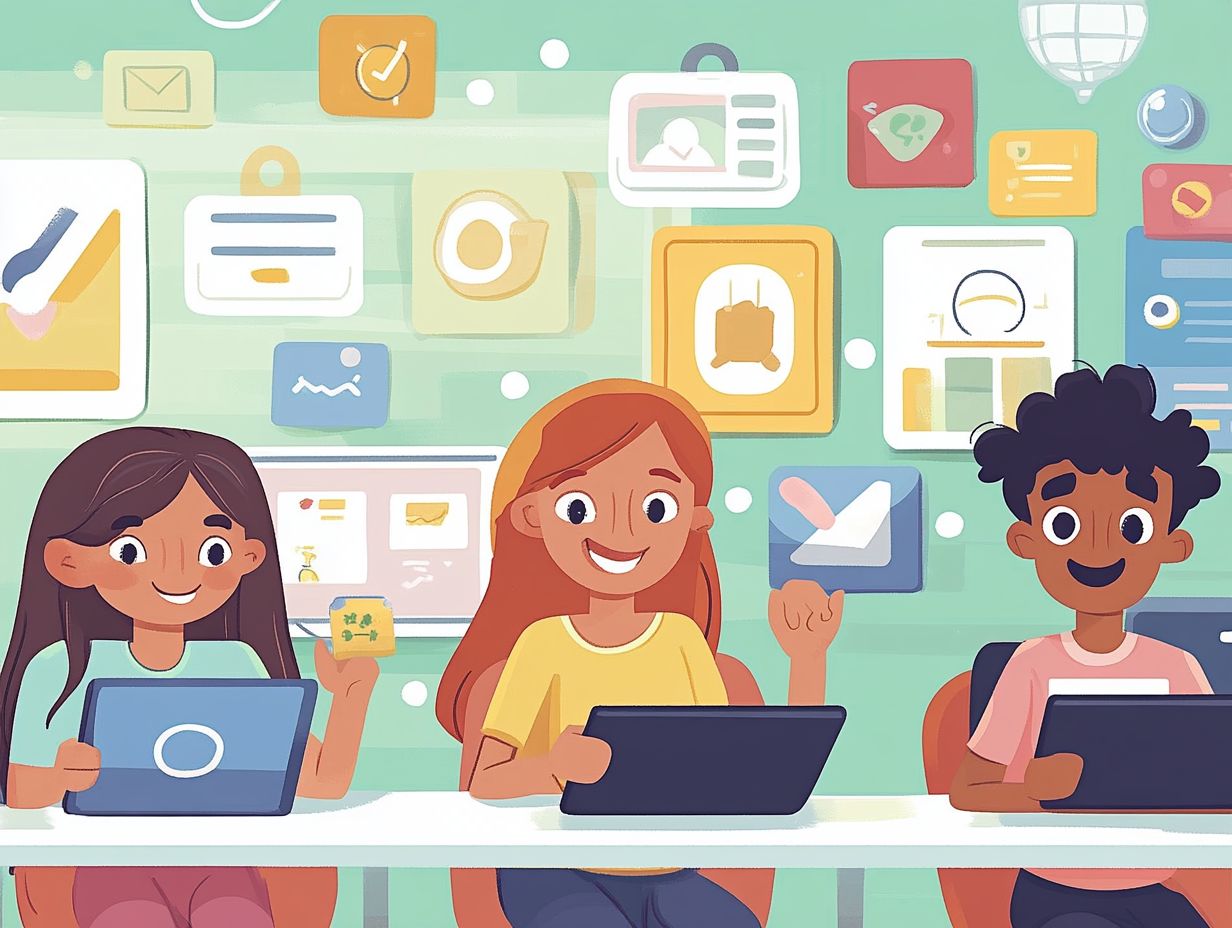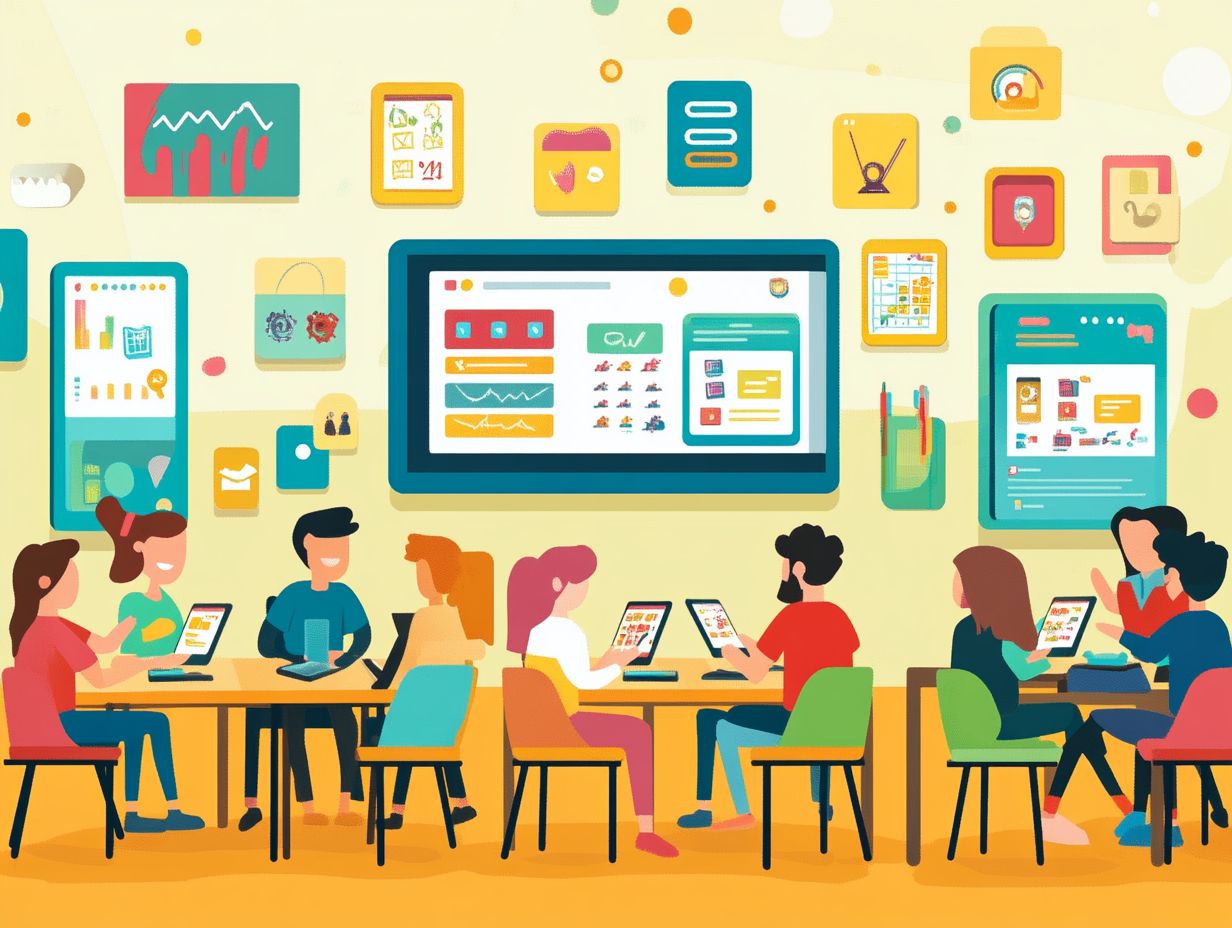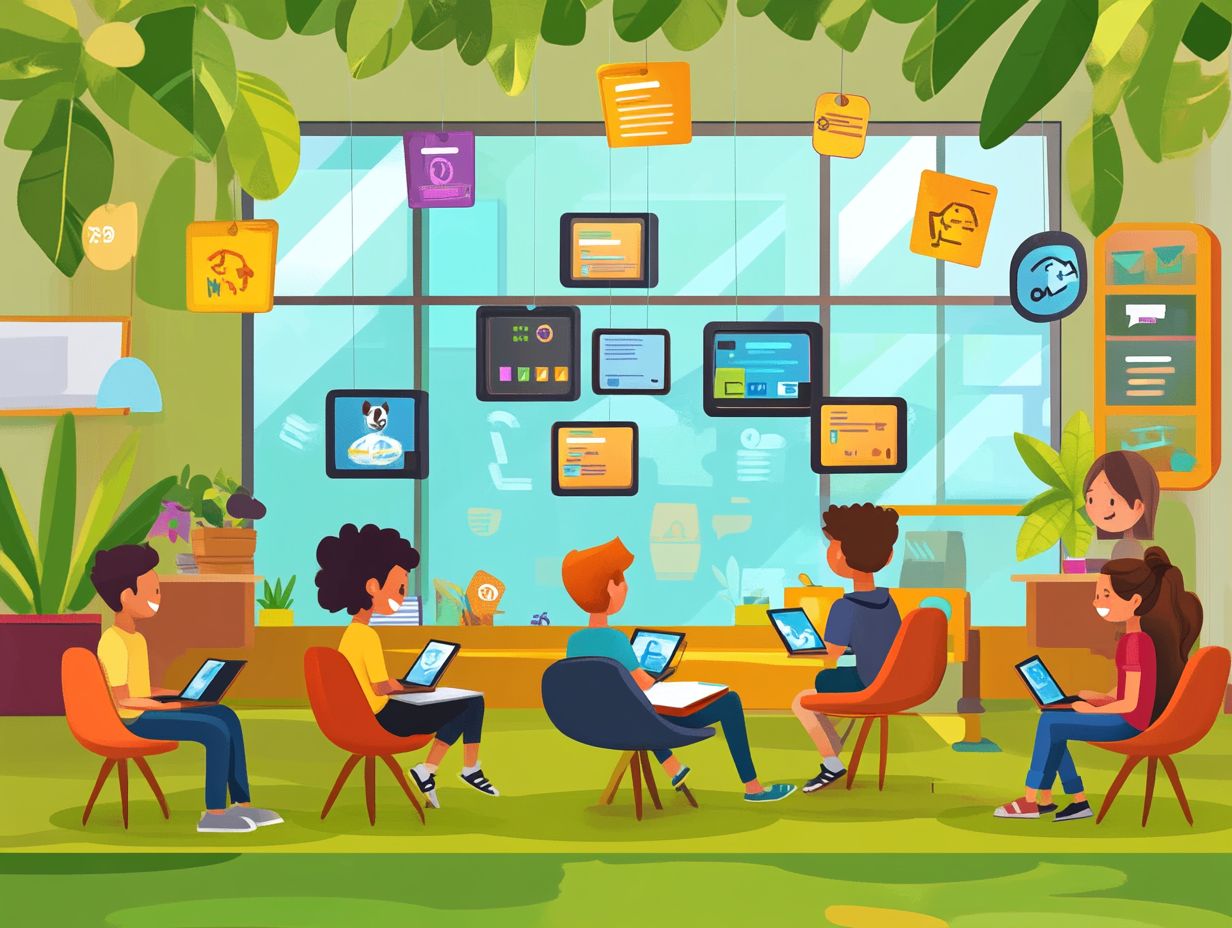Gamification Strategies for E-Learning Engagement
In today s digital landscape, traditional learning methods often find it challenging to capture your attention. Gamification adds game-like features to educational settings, making learning not just effective but also enjoyable.
Let s dive into the exciting benefits of gamification in e-learning, showcasing how it elevates engagement, amplifies motivation, and enhances knowledge retention.
Discover key strategies to implement gamification successfully, along with tips on measuring your success.
Explore how gamification can revolutionize your learning experience!
Contents
- Key Takeaways:
- The Benefits of Gamification in E-Learning
- Key Elements of Effective Gamification
- Gamification Strategies for E-Learning
- Implementing Gamification in E-Learning
- Measuring the Success of Gamification in E-Learning
- Frequently Asked Questions
- What are gamification strategies for e-learning engagement?
- Why are gamification strategies important for e-learning engagement?
- What game elements can boost engagement in online learning?
- How can gamification strategies be implemented in e-learning courses?
- What are the benefits of using gamification strategies for e-learning engagement?
- Are there any potential challenges or drawbacks to using gamification strategies in e-learning?
Key Takeaways:

- Gamification boosts user engagement.
- Successful gamification includes clear goals and rewards.
- Game elements like points and badges enhance learning.
What is Gamification?
Gamification adds game-like features to non-game settings, like e-learning, to elevate your learning experience and engage you more effectively. By incorporating features such as points, badges, leaderboards, and challenges, gamification transforms conventional training programs into interactive learning adventures that spark motivation and promote your autonomy as a learner.
This approach taps into your natural desire for competition and achievement, fostering a more dynamic educational atmosphere. Essential components like feedback systems and progress tracking are crucial, allowing you to grasp your advancements and pinpoint areas for improvement.
Take Khan Academy, for example. Users earn points and badges for completing exercises, which significantly boosts retention rates. Likewise, Duolingo employs gamification by enabling users to reach levels and engage in daily challenges, enhancing vocabulary acquisition while keeping the learning process lively and competitive.
Numerous case studies showcase gamification’s ability to boost participation and drive positive educational outcomes, underscoring its effectiveness in today s learning environments.
The Benefits of Gamification in E-Learning
The advantages of gamification in e-learning are numerous, greatly elevating user engagement and the overall effectiveness of training. This approach also creates immersive content that resonates deeply with learners, supporting ongoing learning initiatives in corporate environments.
Enhanced Engagement and Learning
Enhanced engagement through gamification in e-learning creates deeper learning experiences, fostering an emotional connection with the content. By harnessing immersive content, gamified learning captures your attention, transforming the learning process into something not just enjoyable but also remarkably effective.
This heightened engagement is rooted in how people learn, which shows that when visual and verbal information are processed together, retention improves. For example, when you integrate storytelling elements into online quizzes, they become not only more relatable but also enhance memory retention by placing facts within a narrative framework.
Interactive scenarios, such as branching simulations, give you the power to make choices that lead to different outcomes, further sharpening your critical thinking skills. Companies have reported impressive engagement metrics, with some experiencing up to a 40% increase in quiz completions after implementing gamified elements, demonstrating just how well these strategies resonate with learners like you.
Increased Motivation and Retention
Gamification boosts your motivation and helps you remember what you learn by weaving rewards and recognition into your experience. Elements like badges, points, and leaderboards create a spirited sense of competition, prompting you to reach for that coveted achievement acknowledgment.
This approach uses both internal and external motivators to engage you. For example, when a corporate training program introduces challenges that provide immediate feedback, you are empowered to take charge of your learning journey.
A prime illustration of this is Deloitte University’s Leadership Academy. The incorporation of gamified elements led to an impressive 43% increase in completion rates. It also resulted in a noticeable boost in overall participant satisfaction. These improvements spark more participation and excitement in learning!
Key Elements of Effective Gamification

Key elements of effective gamification for you include clear objectives, timely feedback, and a well-structured system of challenges and rewards. These elements align seamlessly with your training goals.
They not only establish a solid framework for your learning journey but also elevate the overall training experience. You gain both motivation and direction along the way.
Clear Objectives and Feedback
In gamification, having clear objectives is paramount for guiding you through training programs. Effective feedback plays a crucial role in reinforcing your progress and understanding.
By establishing measurable goals, you gain a sense of direction. This transforms the learning process into something structured and impactful.
This structured approach clarifies expectations and empowers you to take charge of your own learning journey. When you know what you need to achieve, you can navigate your tasks with a newfound confidence.
Incorporating feedback loops into this framework is equally vital. Feedback loops involve giving you regular updates on your progress, helping you improve continuously. Timely and constructive feedback allows you to adjust your strategies and enhance your skills.
Strategies like peer reviews and automated progress reports can significantly promote your autonomy, encouraging you to actively engage with your growth. Ultimately, these elements come together to create a dynamic training experience that fosters continuous improvement.
Challenges and Rewards
Incorporating challenges and rewards into gamification can significantly enhance your motivation and engagement. This encourages you to complete tasks and strive for success.
By adopting a system of participation rewards, organizations can cultivate a culture of achievement and continuous learning. This dynamic approach fosters an interactive environment that compels you to actively engage with the material.
Designing challenges that require skill application promotes a deeper understanding and empowers you to tackle real-world problems.
To elevate your experience further, you can integrate various types of rewards, such as visual badges that proudly signify your accomplishments. Whether through leaderboards or certificates, achievement recognition serves as a motivating factor.
This enhances performance tracking and accountability. Together, these strategies create an ecosystem where you are inspired to push your limits while enjoying the learning process.
Gamification Strategies for E-Learning
Gamification strategies for e-learning encompass game-based learning methodologies along with the savvy implementation of points, badges, and leaderboards to elevate user engagement and participation, such as using gamification in employee onboarding.
By weaving these elements into your educational framework, you can cultivate opportunities for social interaction that promote collaboration and foster a vibrant sense of community among learners.
Game-Based Learning
Game-based learning is an incredibly effective strategy. It harnesses interactive experiences to engage you in a meaningful way.
By simulating real-world scenarios, this approach enhances your ability to apply knowledge. It also boosts retention, transforming learning into something enjoyable and impactful.
In the world of corporate training, game-based learning mechanics come alive through point systems, leaderboards, and real-life challenges that mirror workplace situations. Picture your sales team diving into thrilling role-playing games where they negotiate deals in a competitive environment.
All while honing their skills in a risk-free setting!
Companies like Volkswagen have successfully adopted these programs to elevate their employees’ understanding of customer service. This ultimately leads to higher satisfaction rates. This strategy promotes teamwork and ignites motivation through friendly competition, resulting in improved skill development and a vibrant learning experience.
Points, Badges, and Leaderboards

Points, badges, and leaderboards are essential elements of using game-like elements in learning that elevate motivation and engagement in your experience. These components cultivate a competitive atmosphere, encouraging you to strive for achievement and recognition based on your performance and progress.
As you accumulate points for completing tasks, such as finishing a module or hitting milestones, you ll feel a genuine sense of accomplishment. This can significantly boost your morale. Badges act as visual tokens of achievement, adding a personalized touch that enriches your learning journey.
Leaderboards leverage social dynamics, prompting you to compare your progress with peers. This can ignite greater effort and accountability!
To effectively implement these components in corporate training, it s crucial to ensure the system is transparent. Provide regular feedback and keep challenges fresh and exciting.
By thoughtfully integrating these gamified elements, organizations can significantly enhance user engagement metrics. This ultimately leads to better knowledge retention and more effective training outcomes.
Social Interaction and Collaboration
Social interaction and collaboration are essential to the gamification of e-learning. They enrich your overall experience by fostering teamwork and communication.
By creating opportunities for you to engage with your peers, organizations can cultivate a sense of community and shared achievement.
Incorporating strategies like group challenges, collaborative projects, and peer assessments can significantly elevate your training program. This makes it more dynamic and engaging!
For example, implementing game-based activities that require you to work together not only sharpens problem-solving skills but also encourages the sharing of diverse perspectives.
Providing platforms for peer-to-peer feedback allows you and your fellow learners to support each other. This enhances critical thinking abilities and leads to a deeper understanding and retention of knowledge.
This collective approach nurtures relationships among participants. It contributes to a more inclusive and interactive learning environment.
Implementing Gamification in E-Learning
Implementing gamification in e-learning demands meticulous planning and intentional execution. This ensures it seamlessly aligns with your training programs and objectives.
By adhering to best practices and gaining a keen understanding of learners’ needs, you can craft engaging and impactful gamified learning experiences that resonate deeply with your audience.
Tips for Successful Implementation
Implementing gamification requires a strategic approach. Focus on best practices while prioritizing learner engagement and how well learners are doing. By aligning gamified elements with your training objectives, you can significantly enhance the effectiveness of your e-learning initiatives.
To seamlessly integrate gamification into your existing training programs, start by pinpointing the key learning outcomes that align with your overarching goals. For instance, think about incorporating leaderboard systems to inspire your employees to engage actively with training materials. Ensure smooth transitions between gamified elements and traditional learning modules.
Continuous monitoring of performance data is crucial. It allows you to assess what s effective and what isn t in real-time. A corporation that adopted an interactive quiz-based format observed a remarkable 30% increase in knowledge retention.
Regular feedback from learners helps you make necessary adjustments. This ensures that the gamified experiences stay relevant and effective. Ultimately, this approach leads to enhanced skill development and greater employee satisfaction.
Measuring the Success of Gamification in E-Learning
Measuring the success of gamification in e-learning requires you to utilize a range of metrics and evaluation methods to assess its impact on learner engagement and training effectiveness.
By employing performance tracking techniques, you can gather invaluable insights into how well your gamified training initiatives are performing. This enhances your understanding of engagement levels and helps you refine your training strategies for maximum effectiveness.
Metrics and Evaluation Methods

Metrics and evaluation methods are crucial for assessing the success of gamification in e-learning. They empower you to gauge learner engagement and knowledge retention effectively. By leveraging performance data, you can refine your gamified training programs for the best possible outcomes.
Beyond just monitoring user engagement levels, it s crucial to track completion rates. These metrics offer valuable insights into how effectively participants are navigating the designed pathways. A continuous evaluation process uncovers areas that might need tweaking. It also helps you identify patterns and trends in user behavior. This ongoing analysis lets you make quick changes to boost the learning experience!
By staying attuned to participants responses, you can foster a dynamic learning environment that adapts to the needs and preferences of your audience, maximizing the impact of your e-learning initiatives.
Frequently Asked Questions
What are gamification strategies for e-learning engagement?
Gamification strategies for e-learning engagement are techniques used to incorporate game elements, such as points, levels, and rewards, into an online learning experience. To enhance your understanding of these concepts, explore how to use gamification in corporate training. These strategies aim to increase student motivation and participation.
Why are gamification strategies important for e-learning engagement?
Gamification strategies are crucial for e-learning engagement because they make learning enjoyable and interactive, highlighting the role of gamification in e-learning. This leads to increased motivation, engagement, and retention of information.
What game elements can boost engagement in online learning?
Common game elements used in gamification strategies for e-learning include points, levels, leaderboards, badges, and challenges. These elements can enhance quizzes, assignments, and discussions.
How can gamification strategies be implemented in e-learning courses?
Gamification strategies can be implemented in e-learning courses using learning management systems that offer built-in gamification features or by integrating third-party platforms. Understanding how e-learning enhances employee engagement is crucial for instructors as they design their own gamified activities and assessments using various tools and techniques.
What are the benefits of using gamification strategies for e-learning engagement?
Gamification strategies boost student motivation and engagement.
They also improve learning outcomes and help retain information. Plus, you can track student progress and participation using data and analytics.
Are there any potential challenges or drawbacks to using gamification strategies in e-learning?
Gamification strategies can supercharge your e-learning experience, but they have challenges.
Careful planning is needed to ensure game elements match learning goals. Over-gamification can distract students, and not everyone may find the game elements motivating.






